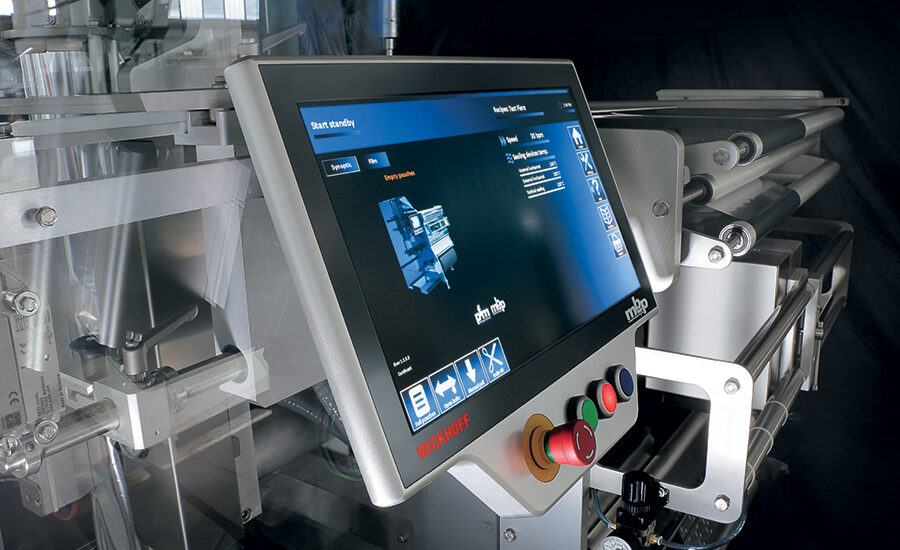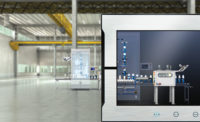No catch-all packaging machine solution exists for every different consumer good, container/material type and plant environment. Similarly, there is no one-size-fits-all human machine interface (HMI) hardware for every packaging application. Machine builders in the packaging industry must select operator interfaces with the correct functionality, screen size and housing type for their applications.
Due to ongoing advances in HMI technology in terms of hardware and software, the range of options keeps growing — creating new solutions for specific machines or lines that will support safer, more modular designs and intuitive operation. Most importantly, it will ensure that the hardware is reliable and up to the job for years to come, since high-quality industrial displays must often last for 20 years or more.
However, while HMI should provide flexibility in its configuration and options, it also must deliver standard features. This extends beyond the e-stop, stop, start and reset buttons that remain popular in packaging applications, and it includes offerings such as HD widescreen displays with multi-touch functionality. These features are necessary to not only empower machine operators with better functionality today, but also to ensure that packaging operations will have the capabilities required in the future.
Reduce Footprint and Clutter Through Streamlined HMI
The trend across all industries is to minimize machine and plant footprint — and shrinking bulky control cabinets or eliminating them entirely has become a top solution. The goal is to integrate more components directly into the machines and factory lines that they control. New HMI hardware meets the demand for increased modularity through multiple means.
Pole-mounted and arm-mounted control panels allow engineers to place the operator interface in the best location, rather than requiring it to be attached to a control cabinet or pendant. For single, larger machines, these control panels can hang from pivoting arms attached to the top of the structure, making them easy to reposition. When controlling entire packaging lines with one control panel, it is often convenient to mount the touchscreens to stands and position them in a central location away from the controller.
Another way to reduce footprint and complexity in the control cabinet is through one-cable technology (OCT) solutions. While OCT options also are available for servo drive and I/O components, one-cable solutions for HMI combine power, digital visual interface (DVI) signal and USB 2.0 signal. OCT options allow controls engineers to locate the HMI mere feet from the controller on an arm-mounted touchscreen or up to 100 meters away from the controller, depending on the application.
Completely eliminating cables between the controller and control panel is another choice. Panel PCs make this possible by integrating a PC-based processor to the back of the touchscreen. Screen sizes for panel PCs can range in size from 7 to 24 inches, with pole-mounted and built-in options. This makes panel PCs beneficial for small sealing machines or large form/fill/seal applications.
Many control panels are now available in portrait orientation, in addition to the traditional landscape. While 3:4 or 4:5 screens are available, the sleeker 16:9 widescreen format is beginning to outpace them. However, this is a case where form definitely follows function, so how control panels look will be determined by how they are used and where.
Stay in Control in Harsh Environments
A top concern when selecting HMI hardware is whether it is suited to the environment. Packaging operations can require extreme cleanliness, but they can also require extreme safety when involving rigorous cleaning procedures or combustible materials.
Stainless steel control panels meet the hygiene standards required by food packaging and other applications, whether using a weight-filler and capper for peanut butter or a tray machine for medical devices. However, hygienic HMI design should not simply rely on the housing material. The control panels should also incorporate flush-mounted touchscreens and beveled edges on the housing to encourage run-off of any spilled products or cleaning solutions.
In especially messy or water-prone areas, the product’s IP or NEMA rating also is important. HMI hardware with an IP65 rating should suffice for nearly every application. Short of total wash-down settings, this rating allows operators to clean the control panel thoroughly without damaging it. These environments also make a compelling case for OCT, which reduces the number of cables that need to be cleaned per control panel by 50 percent.
Applications that involve combustible materials — such as pharmaceuticals, flour, oils and fragrances, or significant amounts of dust — require even more specialized panels. HMI hardware optimized for hazardous areas classified Zone 2/22 often offers the same flexibility of options, including both passive control panels and fan-less panel PCs in a variety of sizes. Engineers should consider which would work best based on the application, yet they should also ensure that each comes with some standard features.
Must-Have HMI Capabilities
Because HMI hardware depends so much on the specific application, software is most commonly seen as the main standardizing force from one machine to the next. The most famous example in packaging applications is the OMAC PackML State Diagram. However, in the plant, control panels and panel PCs must provide certain features that support the advanced requirements of today’s HMI software — and exceed them in order to future-proof the operation.
For HMI hardware with the control panel and controller combined, PC-based control provides the most open, adaptable option. Some panel PCs come equipped with immense processing power, such as quad-core Intel Core i7 or Atom processors, to run both the HMI software and machine control logic. Also, these often have options to add robotics, analytics, measurement and any programs that work in a Windows-based environment.
PC-based control also provides increased connectivity, making it easier to access HTML5-enabled HMI from a remote PC or personal device. This kind of HMI software can dynamically scale the visualization as seen on the machine’s operator interface to any mobile device with a web browser. Depending on the software, there may also be specific apps for smartphones and tablets to monitor and provide push notifications about important machine events. Overall, this promotes more intuitive and transparent HMI across the operation.
Implement Multi-Touch to Use now or Later
Multi-touch functionality is another important must-have feature. These control panels draw on functionality that is common in consumer technology, such as smartphones and tablets, allowing operators to swipe to navigate screens, pinch to zoom and even select specific machines or areas by drawing a box around them. In addition, 3D HMI software makes it possible to fully visualize and interface with entire factory lines or individual machines via dynamic graphical displays.
Operations that do not currently require multi-touch functionality likely will in the future. Multi-touch panels are able to function as single-touch screens if the capability is not immediately necessary; and most importantly, they frequently cost less than comparable single-touch panels. As a result, investing in the more advanced technology is the better option for the future and the present.
As HMI options continue to grow, engineers must choose from control panels that deliver the necessities and a range of options. No single control panel is the best for every packaging application; the demands can vary by project for the packaging machine builder or the end user. By examining all of the options, it is possible to select the HMI that is the perfect fit for your unique application.
Beckhoff Automation is a provider of advanced, open automation products for high performance machines. The company’s product range includes industrial PCs, distributed I/O, automation software, IoT solutions, servo drives and servomotors.
Visit beckhoffautomation.com for more information.




